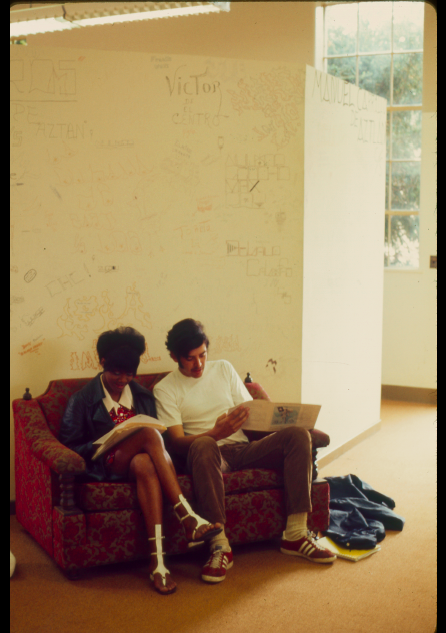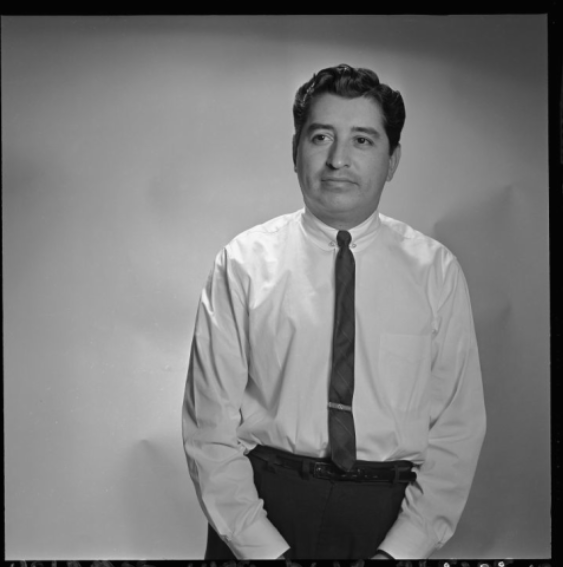
This post is the third section of the talk “Diagonal and Self-Possessed: Group-Portrait with Liminal Figures,” which was given as the keynote address at the 2017 Thinking Its Presence conference, hosted by the University of Arizona Poetry Center.
***
Born at the crossroads with the punk/performance art and music scene of Los Angeles in the late 1970s and early 1980s were budding intellectual passions for experimental theater. That setting included, for example, the Actors Gang, and its version of Alfred Jarry’s Ubu the King (directed by a recent UCLA graduate, the actor Tim Robbins), as well as the electrifying social experience that was Luis Valdez’s Zoot Suit, performed at the Aquarius Theater in Los Angeles in 1979.
Notably performed in the distinctive vocal and physical stylizations of actor Edward James Olmos, the mythical stage creation that was Zoot Suit’s El Pachuco endures in video documentation and in author Luis Valdez’s own 1981 film adaptation of his 1978 play. Clad in solid black drapes and matching fedora, gold crucifix worn over a high-collar crimson shirt, El Pachuco submits a smooth display of diagonal attitude and self-possession—immortalized as much in Ignacio Gomez’s iconic 1978 poster and Aquarius Theater outdoor mural. Poet Joshua Escobar recently reminds me that, “El Pachuco—a figure demonized at the height of 1940’s racial tensions, and in the widely covered legal trails afterward—becomes terrifically inverted through Valdez’s stagecraft, a wildly liminal figure able to slide between foreground and background to instigate and protect, whose voice nearly exceeds the framework of the play.” His most memorable lines were those delivered in Brechtian self-referential (and rhyming) direct address: “I speak as an actor on the stage; the Pachuco was existential for he was an actor on the street, both profane and reverential,” words that echo a method already employed as early as 1967 in Delano, California by Luis Valdez and his production company El Teatro Campesino. Following the United Farm Worker (UFW) leadership of Cesar Chavez and Dolores Huerta, and the stage guidance of budding director Valdez, Mexican-American farmworkers further enhanced the ability to organize and advocate for change in labor practices by means of popular stagecraft.
Rasquache and Existential: Tomás Ybarra-Frausto linked the “rough and tumble performance style” of El Teatro Campesino to the “delight and refinement” found in what is more generally deemed banal, lowly, or uncouth (Tomás Ybarra-Frausto, “Rasquachismo: A Chicano Sensibility,” in Chicano Art: Resistance and Affirmation, 1965-1985). As the “good taste of bad taste,” Ybarra-Frausto further mobilized the meanings of rasquache: “the aesthetic sensibility of los de abajo, of the underdog,” an attitude embodied and exercised by working-class Mexicans and Mexican Americans, “rooted in resourcefulness and adaptability, yet mindful of stance and style.” Chicana artist and theorist Amalia Mesa-Bains offered a feminist critique of the hetero-patriarchal assumptions of early Chicano art formations when she redefined the activist art practice of rasquachismo “as a survivalist irreverence.” (Amalia Mesa-Bains, “Domesticana: The Sensibility of Chicana Rasquache,” in Distant Relations: A Dialogue among Chicano, Irish, and Mexican Artists, 1996)
Although “witty and ironic,” the ethos of rasquache was rarely “mean-spirited,” even when Valdez and his company lampooned the contradictions proper to evolving Mexican-American and Chicano cultural values, as in “Los Vendidos (The Sellouts),” first performed in 1967 for a Brown Beret meeting at Elysian Park in East Los Angeles—later a 1972 Emmy award-winning public broadcasting teleplay. As El Teatro Campesino transitioned from its makeshift rural stages to an urban environment, its creators posed questions about the place of voluntarism in the circuitry of social production, and about commitments to ethnic self, family, society, and history—insofar as the promises of these values are the absurd stuff of tragicomedy. El Teatro Campesino had made charm and swift comic timing crucial to its own pedagogy of the oppressed, deflating the power of so-called social fact by empowering laborers to indulge in the productive play of role reversal. (Valdez: “Put the rancher on the stage but we’ll do the acting!”) In the style of the skeptical Pachuco—archetype of what is required to be an actor on the street—El Teatro Campesino’s through-line can be read allegorically as one that asked the existential questions driving the secret fear and fantasy of action and agency, especially when the cultural manifestations and living styles practiced by a people are subsumed in a recovery process that later renders them symbolic of a preordained authenticity. For a subject in social production, there are no guidelines for the collective enterprise that eschews a view of the past as fixed and unchanging—a museum—but rather optimistically as the open-ended possibility of the ephemeral archive.
*
Hazy sun seeps through a window, enhancing the indoor florescent light as it imbues the scene with a lulled manila glow.
The large windowpane at the upper right is framed in relation to the lighting fixture overhead, angled at the uppermost left. These spatial elements occupy the greater area of the picture—the room itself staggered into planes and angles, as in a stage set—even as you begin to configure the couple seated side-by-side on a couch, each immersed in reading, possibly out loud to one another from the printed matter held in their hands. The lean youth wears a white T-shirt and brown corduroy jeans that match his Adidas suede sneakers. He leans closer, just barely, to the friend with whom he shares a flocked upholstery couch of neo-California colonial design. That’s his jacket and spiral notebook strewn on the floor next to him. She sports a black leather coat, shin-high white-strapped sandals, and a deep red patterned mini-dress accentuating her smooth crossed legs. With her hair styled in an up-do, her face betrays a self-conscious or undecided smile. Does she ponder her companion’s remark, or is it something about the pages in front of her that occupies her thoughts? Or, rather, is it the sudden presence of the photographer clicking the shutter? Are the ocher hues in this interior due to an overcast layer through the foliage or to the forty-year fade of a slide transparency? The moment hangs on such questions of physical relation and style across time, as it does on the different shades of their skin and the indeterminate time of day.
Oscar Castillo recalls that this image “was taken in the early 1970s on a visit that I made to the campus of California Polytechnic University, San Luis Obispo, to help deliver an art exhibit which was loaned to the Chicano university students by Mechicano Art Center. The two [subjects] were studying in the student dorms and this was a candid shot. The exhibit arrangements were made by a graduate architecture student, whose name I unfortunately cannot remember.” Víctor Franco was the founder of Mechicano Art Center, and he had championed community arts and their “direct role in . . . the spiritual uplifting of the people, the masses of people that are downtrodden right now. The minority communities are spiritually dead and I think our main goal is to awaken them spiritually to the point where they can become politically conscious of their environment and what’s happening to them and their lifestyle and hopefully to stimulate them to do something about their condition. . . . It’s a tool for social change” (Victor Franco, oral history interview, July 1972, Smithsonian Archives of American Art, Washington, DC).
In the early 1970s Castillo was in his mid- to late twenties, not much older than the two students in the photograph. Chicano identity too was still in the making, working through its own internal conflicts and its association with the struggles of other oppressed peoples.
A few years before the picture was taken, Los Angeles Times journalist Rubén Salazar reported that “relations between Mexican-Americans and black activists in California colleges and universities—which are cool at best—have deteriorated as a result of a Chicano walkout during an educational opportunity workshop at UC Santa Barbara” (Rubén Salazar, “Black and Chicano Ties Worsen After Walkout at Santa Barbara,” Los Angeles Times, September 15, 1969). An alumnus of San Fernando Valley State College, later Cal State Northridge, Castillo was seasoned in the Mexican American student movement that advanced civil rights even as it ignited youthful conviction across university campuses. Students had already called for a curricular restructuring so that the education universities provided could speak to the knowledge and histories of underrepresented communities. United Mexican American Students (UMAS) of California, together with several nascent Chicano studies departments in the state, sponsored art exhibitions, music events, and theatrical performances, while artist-run venues like Mechicano Art Center and Self Help Graphics & Art were generating exhibitions that sought to bring community art production into the critical spaces of higher learning. Castillo was among the handful of photographers who had documented the Chicano Moratorium (image featured at top), the anti-Vietnam War demonstration in East Los Angeles that led to police hostility and a subsequent outbreak resulting in considerable property damage, 400 arrests, and three fatalities. Most shocking was the death of Rubén Salazar, who had sought respite in the Silver Dollar Café from the violence being waged against the protesters outside. In the already disproportionate police offensive, Deputy Sheriff Thomas Wilson fired a tear-gas projectile at Salazar’s head; the journalist was killed instantly.
Appropriate to the subject of reading is the permanent-marker graffiti on the wall behind the studious couple (“Victor de El Centro,” “Manuel Carrillo de Aztlán”). For me, the photograph similarly holds a place for what Ramón Guitérrez calls the “spatial concept of community,” just prior to the protests or the collective demonstrations, and despite the inter-ethnic arguments of the kind represented by the walkout at an educational opportunity workshop. Instead, the picture insinuates the promise of less-visible moments of intimacy and alliance; that is, of politics by other means. To the extent that the picture hinges on the desire to take action—are the youths studying or drawing up plans for an imminent demonstration?—the then and there of the picture can only be as undecided as that inscrutable smile, or as inadvertent as the connections still activated within the frame: proper names on the wall behind them, everyday life at California Polytechnic University, the gladness of working together in the complicity of joint effort, and the social possibility—our present—awaiting those eventual graduates beyond the amber glow.
[Editor's Note: Some of Tejada’s reading of Castillo’s photograph “Early 1970s, California Polytechnic University, San Luis Obispo,” was adapted from Tejada’s, “Oscar Castillo, Early 1970s, California Polytechnic University, San Luis Obispo.” In The Oscar Castillo Papers and Photograph Collection, edited by Colin Gunckel, 60–61. Los Angeles: UCLA Chicano Studies Research Center Press, 2011.]
A poet, art historian, curator, translator, and editor specializing in Latino and Latin American art...
Read Full Biography




